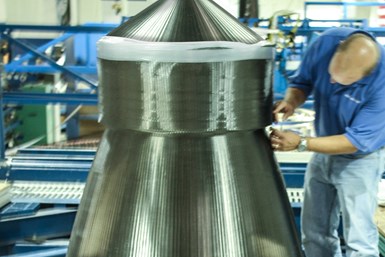A&P Technology awarded SBIR to further inline inspection
A&P Technology was recently awarded an AFWERX SBIR to expedite the development of inline inspection capabilities for braided composite components for hypersonics and military aircraft.
Share

Inline inspection of multi-layered preforms such as this over braided rocket nozzle will enable A&P’s customers to meet high rate production demands. Photo Credit: A&P Technology
A&P Technology Inc. (Cincinnati, Ohio, U.S.) was recently selected by AFWERX, the innovation arm of the Air Force Research Laboratory (AFRL) devoted to developing emerging technologies for defense and providing pathways for commercial applications, for a Direct to Phase II Small Business Innovation Research (SBIR) grant in the amount of $1,245,479. The SIBR is focused on “Innovative, Automated Inline Inspection for High Quality, High-Rate Production Of Braided Composite Components for Hypersonics and Military Aircraft” for the Department of the Air Force (DAF).
The AFRL and AFWERX have partnered to streamline the Small Business Innovation Research (SBIR) and Small Business Technology Transfer (STTR) process by accelerating the small business experience through faster proposal to award timelines, changing the pool of potential applicants by expanding opportunities to small business and eliminating bureaucratic overhead by continually implementing process improvement changes in contract execution. The DAF began offering the Open Topic SBIR/STTR program in 2018 which expanded the range of innovations the DAF funded and on September 28, 2023, A&P Technology began its journey to create and provide innovative capabilities aimed at strengthening the national defense of the United States of America.
“Evolving our existing inline vision inspection capabilities and applying them to multilayer preforms is invaluable to our customers focused on applications demanding both high quality and high rate,” says Pam Schneider, COO at A&P Technology. “This SBIR will enable A&P to meet the demands of our customers servicing the U.S. Military, including those building autonomous collaborative platforms (ACP), hypersonic vehicles, and advanced air mobility (AAM) aircraft.”
Related Content
-
Infinite Composites: Type V tanks for space, hydrogen, automotive and more
After a decade of proving its linerless, weight-saving composite tanks with NASA and more than 30 aerospace companies, this CryoSphere pioneer is scaling for growth in commercial space and sustainable transportation on Earth.
-
The lessons behind OceanGate
Carbon fiber composites faced much criticism in the wake of the OceanGate submersible accident. CW’s publisher Jeff Sloan explains that it’s not that simple.
-
Cryo-compressed hydrogen, the best solution for storage and refueling stations?
Cryomotive’s CRYOGAS solution claims the highest storage density, lowest refueling cost and widest operating range without H2 losses while using one-fifth the carbon fiber required in compressed gas tanks.












